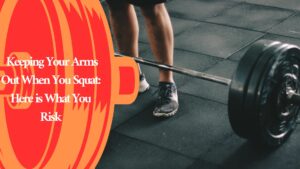Squats are a staple exercise for building lower body strength and power, but did you know that the position of your arms can make a big difference in your results?
Keeping your arms out in front of you when squatting is a popular technique, but is it really safe and effective?
In this post, we’ll explore the risks and benefits of this arm position and help you make an informed decision about how to optimize your squat form.
Keeping your Arms Out in Front of you When you Squat is incorrect here are the reasons why and the risks involved:
- Keeping arms out in front will put more stress on the wrists and elbows.
- Can decrease the squatting position’s stability.
- It can cause lower back pain.
- It can lead to inaccurate movement patterns.
- can cause the knees to come in front of the toes.
Can put more stress on your wrists

Can decrease the squatting position and the stability.
It can cause lower back pain.
It can lead to inaccurate movement patterns.
Can cause the knees to come in front of the toes.
Conclusion
In conclusion, keeping your arms out in front of you when squatting can be a risky move that puts unnecessary strain on your back, shoulders, and wrists.
While it may provide some benefits in terms of balance and stability, there are better ways to achieve these goals without sacrificing your safety or performance.
By focusing on proper form and alignment, you can get the most out of your squats and reach your fitness goals with confidence.

Hey there, it’s Mike Rrsq, the Editor-in-Chief over at Jsquat.com, and I’m absolutely obsessed with all things squat fitness! I’ve been lucky enough to get some serious recognition for my work in this field. With a solid background in the fitness and wellness industry, I’ve been there right from the get-go, helping shape this website into what it is today.
You see, I’m not just the boss around here; I’m also a passionate contributor. I love sharing my insights through my articles, and trust me, they’re not your run-of-the-mill stuff. Each piece I write is a labor of love, filled with my expertise and real-world experience in the fitness universe. So, if you’re into fitness and looking for some inspiration, you’re in the right place!
